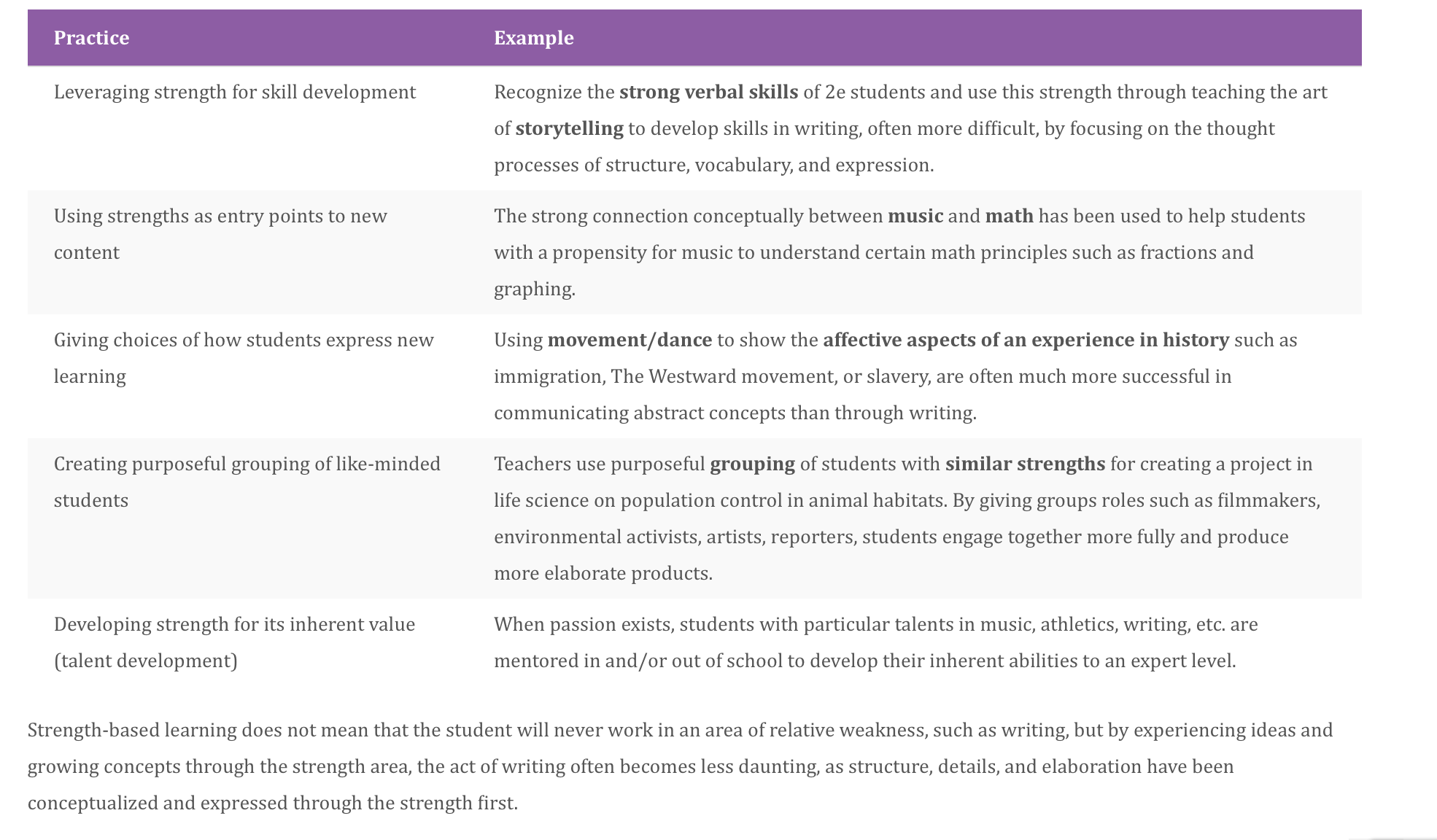Lesson 4: Looking Beyond the Academics
Focus on Assets
A pattern in research is that students who are identified for special education before their talents are identified are less likely to receive talent programming (Belin-Blank, NAGC, 2020). As was emphasized in the Part 1 course, it is important for the success and well-being of this population that we take a strengths-based approach. The best educational plans for twice-exceptional students highlight strengths and then accommodate weaknesses--in that order.
Research from 2e school, Bridges Academy (Baum, Schader, & Hebert, 2014) revealed that a strengths-based approach that emphasized talent development helps 2e learners: gain a sense of belonging in social group; overcome challenges; develop relationships with mentors; develop expertise in a talent area, and that by incorporation of strengths-based philosophy across curriculum students ' had increased motivation and willingness to address weaknesses (across academic areas).
Twice-exceptional learners should be provided with the opportunity to participate in advanced classes, enrichment activities, or acceleration. Students receiving IEPs or 504 plans are often overlooked for acceleration programming. In 2008, Crim et al. examined IEPs of over one thousand students identified with SLD; 112 were identified as high ability on cognitive measures, but not one was recommended for acceleration programming.Acceleration is one of the effect programming options to means meet a 2e learners gifted needs, but like other programming options, such as advanced courses, it must be accompanied by relevant accommodations--remember dual differentiation from the Part 1 course--which starts by understanding the student’s unique pattern of strengths and weaknesses, and accommodating accordingly. Because of the complexity and heterogeneity in 2e students' skills, curricula should be uniquely tailored to individual needs. For example, a gifted student with dyslexia may be provided with the opportunity to build reading skills within intellectually engaging lesson (Berninger & Abbot, 2013), or a gifted student with ADHD may be provided with the opportunity to cultivate divergent thinking and problem-based learning rather than activities reliant on recollection of fact (Fugate, Zentall, & Gentry, 2013).
Many 2e learners will benefit from allowing them enough time to process information (sometimes adults can misinterpret behavior as defiant when a learner is taking more time to process because of a learning difference) and being taught self-advocacy and problem-solving skills. (in both areas of talent and weakness, especially as they get older)
Although we covered strength-based learning in Part 1, this new article: What Do We Mean By Strength-Based Learning provides ways to incorporate strengths and provides examples.

“Teachers initially view the high creativity, critical thinking, curiosity, and problem-solving ability of twice-exceptional learners as exciting, challenging, and positive. But teachers’ enthusiasm for these positive characteristics soon becomes overshadowed by their frustration with these students’ inability to demonstrate academic skills and with their often extreme behavioral difficulties” (Nielson and Higgins, 2005).
2e students are often very frustrating to teachers in the classroom. They don't "play school" well and their own frustration with their uneven abilities, or lack of understanding of how they fit in, leads to behaviors that can be challenging in the classroom. Despite these frustrations, we must remain steadfast to looking at all of their strengths (assets) before trying to work on their struggles (deficits).
This is true in education and life. Let's take a look at an article written by Donnie Maclurcan, who is a co-founder of the Post Growth Institute and an Affiliate Professor of Social Science at Southern Oregon University. His article,
The Power of Asset-based Approaches, gives a glimpse into how a strength-based mindset, or being asset focused, is powerful in all areas of life. (Take some time to click the links below to view the resources shared by Maclurcan; reading the entire article is optional.)
"From the moment you were born, you have been accumulating an incredible array of assets. No matter who you are – your passions, knowledge, skills and access to resources are truly vast."
According to Maclurcan, "when we open processes by reviewing the positives, we engage the imaginative neocortex, not the part of our brains associated with ‘flight, fight or freeze’ response. This enables greater creativity and a “flexible, responsive approach to situations”." Maclurcan does not advocate for a false, cheery disposition that avoids or ignores the real challenges. Instead, he has found that "we start by exploring people’s strengths, we value people as human beings."
Let's take this one step further ... What are the students saying? According to Gallup ( Strengths-Based Education and Student Engagement
by Shane J. Lopez, Ph.D.), "commitment to building the strengths of each student is associated with several of the conditions necessary for student engagement."
84% of students who strongly agreed with “My school is committed to building the strengths of each student” were engaged at school.
As found in The Principles of Strengths-Based Education, strengths-based education is built upon the following assumptions:
- The strengths philosophy explores ways to empower individuals to flourish rather than simply survive (Liesveld & Miller, 2005) and presupposes that capitalizing on one’s best qualities is likely to lead to greater success than would be possible by making a comparable investment of effort into overcoming personal weaknesses or deficiencies (Clifton & Harter, 2003; Clifton & Nelson, 1992).
- Strengths-based models embody a student-centered form of education with the primary goal of transforming students into confident, efficacious, lifelong learners whose work is infused with a sense of purpose (Anderson, 2000).
Shane J Lopez & Michelle C Louis (2009) The Principles of Strengths-Based Education, Journal of College and Character, 10:4, , DOI: 10.2202/1940-1639.1041
What assets does your 2e student bring to your classroom? What are their passions? Knowledge? Skills? Start here...